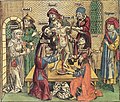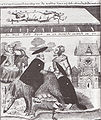Simon of Trent
Simon of Trent | |
|---|---|
 | |
| Born | 1472 Trento, Prince-Bishopric of Trent, Holy Roman Empire (now Italy) |
| Died | March 1475 Trento, Prince-Bishopric of Trent, Holy Roman Empire |
| Venerated in | Catholic Church (Folk Catholicism) |
| Beatified | Veneration permitted 1588 by Pope Sixtus V |
| Canonized | No |
| Feast | 24 March |
| Attributes | Youth, martyrdom |
| Patronage | Children, kidnap victims, torture victims |
| Controversy | Blood libel |
Catholic cult suppressed | 1965 by Pope Paul VI |
Simon of Trent (
Events
At the time of the events, Prince-Bishop
The events themselves have been reconstructed from a careful study of
Following the report of the body's discovery, the entire Jewish community (both men and women) were arrested and forced under torture to confess to having murdered Simon to use his blood for ritual purposes (a classic example of the blood libel that Jews used Christian blood in their rituals). An examination of the corpse by city doctors determined that Simon had not died of natural causes but had been exsanguinated. In Hsia's view, "the narrative imperative, the official story of ritual murder, the trial record of 1475–76, represents nothing less than a Christian ethnography of Jewish rites".[9]
Fifteen of the Jews, including Samuel, the head of the community, were sentenced to death and
Papal investigation
On 3 August 1475,
In the face of persistent hostility, he relocated to Rovereto, which was then under Venetian control,[12] and summoned Hinderbach and the podestà to answer for their conduct. Instead of appearing, Hinderbach had an account of the proceedings drawn up to vindicate his own actions, circulating it widely and so giving general credence to the notion that Simon of Trent had in fact been murdered by Jews.
The case was reviewed in Rome, where Hinderbach had powerful friends, including the papal librarian
Veneration

The Martyrdom of Saint Simonino
Simon became the focus of attention for the local Catholic Church. The local bishop, Hinderbach of Trent, tried to have Simon canonized, producing a large body of documentation of the event and its aftermath.[14] Over one hundred miracles were directly attributed to Simon within a year of his disappearance, and his cult spread across Italy, Austria and Germany. However, there was also skepticism from the beginning, as Giudici's investigation showed.
Maximilian I, a future Holy Roman Emperor, was a strong proponent of Simon's veneration and commissioned a silver monument of the child.[15] He also had Simon's relics carried in procession when he was made emperor in 1508.
The veneration received wider liturgical impetus in the 16th century. Joannes Molanus included a footnote on Simon of Trent in his 1568 edition of Usuard's martyrology,[16] and this was then incorporated into the new official edition of the Martyrologium Romanum in 1583,[17] with 24 March having the additional text: Tridenti passio sancti Simeonis pueri, a Judaeis saevissime trucidati, qui multis postea miraculis coruscavit. ("At Trent, the suffering of the holy boy Simeon, barbarously murdered by the Jews, who was afterwards glorified by many miracles.")[18] In 1584 the use of this martyrology became obligatory in the Roman Rite. Furthermore, in 1588 Pope Sixtus V gave recognition to the local veneration of Simon as an established devotion, functionally equivalent to a decree of beatification.[15] Simon could thus be considered a martyr and a patron of kidnap and torture victims.
In 1758, Cardinal Ganganelli (later Pope Clement XIV, 1769–1774) prepared a legal memorandum which, to the exclusion of all other allegations of ritual murders of infants which records were thoroughly made available to him, expressly admitted as proven only two: that of Simon of Trent and that of Andreas Oxner.[19] At the same time, he extols the glories and accomplishments of the Jewish people across history, writing that the murder of Simon of Trent does not suffice to injure the reputation of the entire Jewish people.[20]
Simon's cultus was permitted by the Popes for local public liturgical observance (effectively beatification) within the Diocese of Trent.[15] In a letter to Fr. Benedetto Veterani, Promoter of Faith, Pope Benedict XIV recognised that this was the case, but was careful to distinguish such authorization from canonization.[21][22]
As was stated in one publication, "It is simply untrue to say that the Church has canonized little Simon of Trent. A decree of beatification was issued by Sixtus V, which took the form simply of a confirmation of cultus and which allowed a Mass to be said locally in honour of the boy martyr. Everyone knows that beatification differs from canonization in this, that in the former case the infallibility of the Holy See is not involved, in the latter it is."[23]
Following studies on the case, on 28 October 1965 (the same day as the publication of Nostra aetate by Pope Paul VI) archbishop of Trent Alessandro Maria Gottardi abolished the cult of Simon, and the yearly procession with his relics was suppressed.[24][25] Simon of Trent is not in the new Roman Martyrology of 2000, nor on any modern Catholic calendar.[15] His relics, removed from their resting place in Saints Peter and Paul church in Trent upon the cult's suppression, were returned there in 2021, together with an exhibit about him curated by the Museo diocesano tridentino.[26]
Controversies
In the 21st century, historian Ariel Toaff, writing about the case of Simon of Trent, hypothesized that the notion that some Jews killed children to use their blood for ritual purposes may have been tenuously based on an actual "ritual of blood" that did not involve infanticide. In the same work, Passovers of Blood, Toaff theorises that some blood libel cases may be based on actual instances of infanticide where a Jewish perpetrator acted in retaliation for persecutions against the community.[27] After criticism, the book was withdrawn from circulation and redacted by its author.[28][29]
In 2020, the Italian artist Giovanni Gasparro painted a depiction of Simon's death. He was later accused of Antisemitism for this painting which sold to a private collector.[30]
In February 2022, a sculpture of Simon of Trent depicting the blood libel was used by
Image gallery
-
Altobello Melone, Simon of Trent, ca.1521, oil on panel, Castello del Buonconsiglio, Trent (Italy)
-
Unknown painter, Ex voto; fresco, end of the 15th century, church of Santa Maria Annunciata, Bienno (BS), Italy
-
Incunabulum of Friedrich Creussner, Nuremberg, 1475
-
Simon of Trent's martyred body. Engraving, Nürnberg, around 1479.
-
Stone medallion with the purported martyrdom scene of Simonino di Trento. Palazzo Salvadori, Trent
-
Illustration in Hartmann Schedel's Weltchronik, 1493
-
Unknown painter, fresco, end of the 15th century, church of Santa Maria Annunciata, Bienno (BS), Italy
-
Statue of Simon of Trent on the facade of a palace in Trento (situated in "Via del Simonino")
-
Martyrdom of Simon of Trent above a Judensau.
-
Martyrdom of Simon of Trent above a Judensau.
See also
- Blood libel
- Little Saint Hugh of Lincoln
- William of Norwich
- Werner of Oberwesel
- Andreas Oxner
- Robert of Bury
- Harold of Gloucester
- Prozess gegen die Juden von Trient
- Raphael Levy
References
Citations
- ^ "St Simon of Trent". British Museum. Archived from the original on 14 December 2020. Retrieved November 29, 2020.
- ISBN 9780195399301. Archived from the originalon 8 April 2023. Retrieved November 29, 2020.
- ^ (Hsia 1992, pp. 14–15)
- ^ (Hsia 1992, p. 25)
- ^ a b (Hsia 1992, p. 16)
- ^ a b c (Hsia 1992, pp. 26–27)
- ^ a b c d (Hsia 1992, pp. 1–3)
- ^ (Hsia 1992, p. 29)
- ^ (Hsia 1992, p. 94)
- ^ (Hsia 1992, pp. 95–104)
- ^ (Hsia 1992, pp. 128–129)
- ^ a b c Quaglioni, Diego (2001). "Giudici, Battista dei". Dizionario Biografico degli Italiani (in Italian). Vol. 56. Archived from the original on 1 July 2022.
- ^ (Hsia 1992, p. 127)
- JSTOR 3622714.
- ^ S2CID 192405280– via Google Books.
- OCLC 902173278.
- OCLC 319912070.
- OCLC 645647197.
- ^
 Jacobs, Joseph; Broydé, Isaac (1901–1906). "Clement XIV. (Lorenzo Ganganelli)". In Singer, Isidore; et al. (eds.). The Jewish Encyclopedia. New York: Funk & Wagnalls. Archived from the original on 8 April 2023.
Jacobs, Joseph; Broydé, Isaac (1901–1906). "Clement XIV. (Lorenzo Ganganelli)". In Singer, Isidore; et al. (eds.). The Jewish Encyclopedia. New York: Funk & Wagnalls. Archived from the original on 8 April 2023.
- ^ Lobe, Isidore (January–March 1889). "Un Mémoire de Laurent Ganganelli sur la Calomnie du Meurtre Rituel". Revue des Études Juives (in French). XVIII. Peeters Publishers: 179 et seq – via Google Books.
- ^ Melzer, Gottfried, Excerpts from The Bull Beatus Andreas of Pope Benedict XIV of 22 February 1755 [with comments], translated by Belser, R., archived from the original on 13 June 2023,
As We have shown in Our work De Canonisatione, Book 3, Chapter 15, Nr. 6, Pope Sixtus IV by a Papal brief thereupon approved the Mass celebration and the Office in his [Simon's] name, to be read on the fixed day in the city and the entire bishopric of Trent, to the honor of the Blessed Simon, and (the Pope) moreover granted a plenary indulgence to all those who, having had the Sacrament of Confession and Communion, visit the church in which his relics are venerated on his day of the year." (S.5.) "And if, nevertheless, as we have further said above, at the behest of Pope Gregory XIII, the name of the Blessed Simon has been added to the Roman Martyrology, it can however not be inferred that because of this the latter has been canonized." (S.21.)
- National Library of Naples. Bartholomaei Occhi. pp. 215.
- OCLC 1589103– via Google Books.
- .
- ^ Rogger, Iginio (8 February 2007). "Interventi sul caso Toaff di storici italiani che si sono occupati dell'accusa del sangue: mons. Iginio Rogger (Avvenire, 8 febbraio 2007)". Avvenire (in Italian). Archived from the original on 1 February 2023 – via CESNUR.
- ^ Franchi, Fabrizio (19 January 2021). "Le reliquie del Simonino torneranno alla cappella di San Pietro". l'Adige (in Italian). Archived from the original on 30 January 2023.
- Ynetnews. 11 February 2007. Archived from the originalon 15 April 2023. Retrieved 5 May 2021.
- ^ Palmieri-Billig, Lisa (7 February 2007). "Historian gives credence to blood libel". The Jerusalem Post. Archived from the original on 9 April 2023.
- ^ Schwartz, Adi (24 February 2008). "Bar-Ilan Scholar Recants Controversial Blood Libel Theory". Haaretz. Archived from the original on 16 April 2022.
- ^ Reich, Aaron (27 March 2020). "Italian artist accused of antisemitism for new painting of blood libel". The Jerusalem Post. Archived from the original on 12 April 2023.
- ^ Lee, Ella (3 February 2022). "Fact check: Sculpture is evidence of antisemitic 'blood libel,' not false QAnon theory". USA Today. Archived from the original on 8 April 2023. Retrieved 6 February 2022.
- ISBN 978-1-80096-046-6.
Bibliography
- Curzel, Emanuele (2018). "SIMONE da Trento". Istituto della Enciclopedia Italiana. Archived from the originalon 31 March 2023.
- Eckert, Willehad Paul (1964). Eckert, Willehad Paul; Ehrlich, E. L. (eds.). Judenhass: Schuld der Christen?! Versuch eines Gesprächs. Essen: Hans Driewer. pp. 329–357. OCLC 8989370.
- Gentilini, Gianni (2007). Pasqua 1475: Antigiudaismo e lotta alle eresie il caso di Simonino. Milano: Medusa. ISBN 9788876981227.
- ISBN 0-300-06872-7.
- Menestrina, Giuseppe (October 1903). "Gli Ebrei a Trento". Tridentum Rivista Mensile di Studi Scientifici. 6: 304–411.
- Treue, Wolfgang (1996). Der Trienter Judenprozeß: Voraussetzungen - Abläufe - Auswirkungen; (1475 - 1588). Hannover: Hahnsche Buchhandlung. ISBN 9783775256131.
- Treue, Wolfgang (2015). "Diplomaten, Rechtsgelehrte, Intriganten: Der Trienter Judenprozess vor der römischen Kurie 1475–1478". In Füllenbach, Elias H.; Miletto, Gianfranco (eds.). Dominikaner und Juden: Personen, Konflikte und Perspektiven vom 13. bis zum 20. Jahrhundert / Dominicans and Jews: personalities, conflicts, and perspectives from the 13th to the 20th century. Berlin: ISBN 9783050087917.










